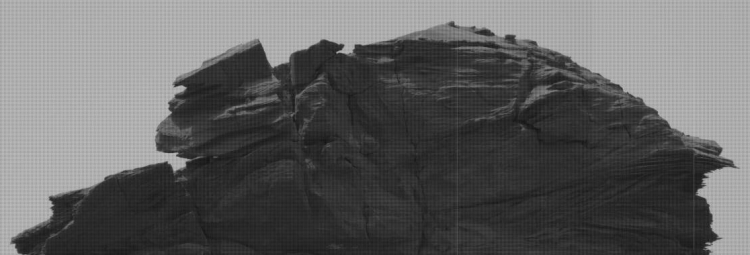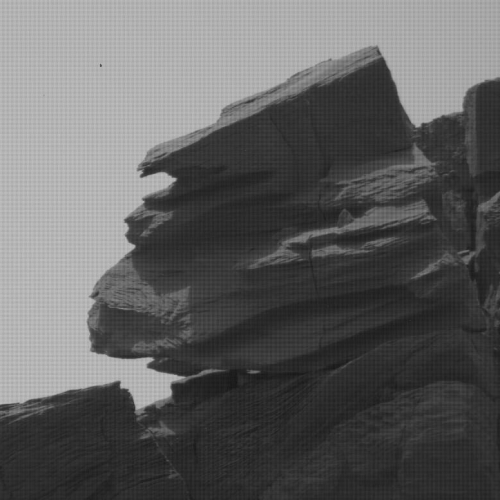A floating Martian rock

For original images, click here and here.
Cool image time! As Curiosity begins the slow and careful journey up through the rocky Gordon Notch onto the even rockier Greenheugh Pedimont layer above, the science team is using its cameras to take pictures of the buttes that form the northern and southern walls of that notch.
The mosiac above and the photo to the right, both cropped and reduced to post here, is one beautiful example. Taken by Curiosity’s high resolution camera on February 11th, both images show the consequences on geology of Mars’ low gravity, one third that of Earth’s. The top image shows the entire top of the butte, with the picture to the right focusing on one boulder that almost seems to be floating in the air. Look close and you can see daylight under the rock’s entire left half.
I think this butte is the north wall of Gordon Notch, but am not sure. Either way, the photos once again demonstrate that it is very dangerous to assign our Earth-based assumptions to Martian geology. There may be similarities, but the differences must not be ignored, or else our conclusions about what we see will be wrong.
On Christmas Eve 1968 three Americans became the first humans to visit another world. What they did to celebrate was unexpected and profound, and will be remembered throughout all human history. Genesis: the Story of Apollo 8, Robert Zimmerman's classic history of humanity's first journey to another world, tells that story, and it is now available as both an ebook and an audiobook, both with a foreword by Valerie Anders and a new introduction by Robert Zimmerman.
The print edition can be purchased at Amazon or from any other book seller. If you want an autographed copy the price is $60 for the hardback and $45 for the paperback, plus $8 shipping for each. Go here for purchasing details. The ebook is available everywhere for $5.99 (before discount) at amazon, or direct from my ebook publisher, ebookit. If you buy it from ebookit you don't support the big tech companies and the author gets a bigger cut much sooner.
The audiobook is also available at all these vendors, and is also free with a 30-day trial membership to Audible.
"Not simply about one mission, [Genesis] is also the history of America's quest for the moon... Zimmerman has done a masterful job of tying disparate events together into a solid account of one of America's greatest human triumphs."--San Antonio Express-News

For original images, click here and here.
Cool image time! As Curiosity begins the slow and careful journey up through the rocky Gordon Notch onto the even rockier Greenheugh Pedimont layer above, the science team is using its cameras to take pictures of the buttes that form the northern and southern walls of that notch.
The mosiac above and the photo to the right, both cropped and reduced to post here, is one beautiful example. Taken by Curiosity’s high resolution camera on February 11th, both images show the consequences on geology of Mars’ low gravity, one third that of Earth’s. The top image shows the entire top of the butte, with the picture to the right focusing on one boulder that almost seems to be floating in the air. Look close and you can see daylight under the rock’s entire left half.
I think this butte is the north wall of Gordon Notch, but am not sure. Either way, the photos once again demonstrate that it is very dangerous to assign our Earth-based assumptions to Martian geology. There may be similarities, but the differences must not be ignored, or else our conclusions about what we see will be wrong.
On Christmas Eve 1968 three Americans became the first humans to visit another world. What they did to celebrate was unexpected and profound, and will be remembered throughout all human history. Genesis: the Story of Apollo 8, Robert Zimmerman's classic history of humanity's first journey to another world, tells that story, and it is now available as both an ebook and an audiobook, both with a foreword by Valerie Anders and a new introduction by Robert Zimmerman.
The print edition can be purchased at Amazon or from any other book seller. If you want an autographed copy the price is $60 for the hardback and $45 for the paperback, plus $8 shipping for each. Go here for purchasing details. The ebook is available everywhere for $5.99 (before discount) at amazon, or direct from my ebook publisher, ebookit. If you buy it from ebookit you don't support the big tech companies and the author gets a bigger cut much sooner.
The audiobook is also available at all these vendors, and is also free with a 30-day trial membership to Audible.
"Not simply about one mission, [Genesis] is also the history of America's quest for the moon... Zimmerman has done a masterful job of tying disparate events together into a solid account of one of America's greatest human triumphs."--San Antonio Express-News



“Look close and you can see daylight under the rock’s entire left half.”
Your point about the low gravity is well taken, but I suggest that a part of that air-gap is reflected light on the flat surface of a lower slab of rock.
Ray Van Dune,
By “reflected light on the flat surface,” do you mean reflection that is backscatter, mirror-like, or grazing incidence off the flat rock, which would still pass under the “floating” rock?